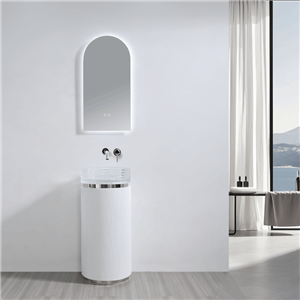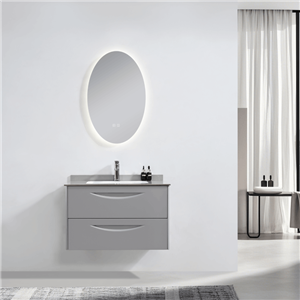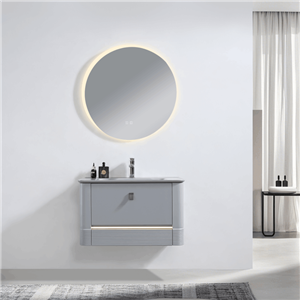Bathroom Vanity Manufacturing: From Concept to Completion
Bathroom vanities are essential components of modern bathrooms, combining functionality and aesthetics to create a comfortable and stylish space. The process of manufacturing bathroom vanities involves numerous steps, from the initial concept to the final product. Understanding these steps can help consumers make informed decisions when selecting a vanity and can also provide insight into the craftsmanship and quality involved in their production. In this blog, we will explore the entire process of bathroom vanity manufacturing, from concept to completion.
What is Bathroom Vanity Manufacturing?
Bathroom vanity manufacturing refers to the process of designing, producing, and assembling bathroom vanities. These units typically include a sink, countertop, and storage space, and are designed to fit various bathroom styles and sizes. The scope of manufacturing encompasses everything from material selection and design to quality control and finishing.
Key Components of a Bathroom Vanity
A standard bathroom vanity consists of several key components:
Base Cabinet: Provides storage space and supports the countertop and sink.
Countertop: The surface area around the sink, often made of materials like granite, quartz, or marble.
Sink: The basin used for washing han
ds and face, which can be integrated into the countertop or mounted separately.
Faucet: The fixture that controls water flow into the sink.
Hardware: Includes handles, knobs, and hinges for doors and drawers.
How Bathroom Vanity Manufacturing Begins: The Concept Phase
Understanding Customer Needs and Preferences
The first step in bathroom vanity manufacturing is understanding the needs and preferences of customers. Manufacturers often conduct market research, gather customer feedback, and analyze trends to determine what features and styles are in demand.
Market Research and Trend Analysis
Market research involves studying current trends in bathroom design, materials, and technology. This helps manufacturers stay competitive and offer products that meet consumer expectations. Trend analysis can reveal preferences for specific materials, colors, finishes, and design elements.
Initial Design and Prototyping
Once customer needs and market trends are understood, the initial design phase begins. Designers create sketches and 3D models of the vanity, considering both aesthetic and functional aspects. Prototyping allows manufacturers to test designs and make necessary adjustments before full-scale production.
The Design Process in Bathroom Vanity Manufacturing
How to Choose the Right Materials
Selecting the right materials is crucial for both the durability and appearance of the vanity. Common materials include wood, MDF (Medium Density Fiberboard), plywood, and PVC. Each material has its own advantages and disadvantages, which will be discussed later in this blog.
Importance of Functional and Aesthetic Design
A well-designed bathroom vanity should be both functional and visually appealing. Designers must balance storage needs, countertop space, and the overall look of the vanity to create a product that enhances the bathroom's usability and style.
Using Technology and Software in Design
Modern technology plays a significant role in the design process. CAD (Computer-Aided Design) software allows designers to create precise 3D models, make quick adjustments, and visualize the final product. This technology streamlines the design process and ensures accuracy.
What Materials Are Used in Bathroom Vanity Manufacturing?
Overview of Common Materials
The choice of materials significantly impacts the quality, durability, and cost of the bathroom vanity. Here is an overview of some common materials used in manufacturing:
| Material | Description | Advantages | Disadvantages |
|---|---|---|---|
| Wood | Natural material, often used for high-end vanities | Durable, luxurious appearance, can be refinished | Expensive, requires maintenance, susceptible to water damage |
| MDF (Medium Density Fiberboard) | Engineered wood product made from wood fibers and resin | Affordable, smooth surface, easy to paint | Less durable than solid wood, can swell with moisture |
| Plywood | Layers of wood veneer glued together | Strong, resistant to warping, more affordable than solid wood | Visible edges need covering, can delaminate if exposed to water |
| PVC (Polyvinyl Chloride) | Synthetic plastic material | Waterproof, low maintenance, affordable | Less sturdy than wood or MDF, can look less premium |
Advantages and Disadvantages of Each Material
Wood: Wood offers a luxurious appearance and durability but comes with a higher cost and requires regular maintenance to prevent water damage.
MDF: MDF is affordable and provides a smooth surface for painting, but it is less durable and can swell when exposed to moisture.
Plywood: Plywood is strong and resistant to warping, making it a good middle-ground option, though it needs edge treatment to prevent delamination.
PVC: PVC is waterproof and low maintenance, making it a practical choice for bathrooms, but it may not provide the same premium look and feel as wood or MDF.
How to Select the Best Material for Your Needs
When selecting a material for your bathroom vanity, consider factors such as budget, aesthetic preferences, and the bathroom's humidity levels. For instance, solid wood may be ideal for a luxurious master bathroom, while PVC could be better suited for a high-moisture environment like a children's bathroom.
The Manufacturing Process: From Raw Materials to Finished Product
Step-by-Step Manufacturing Process
The manufacturing process of a bathroom vanity involves several steps, each crucial to the final product's quality and durability.
Cutting and Shaping: Raw materials are cut and shaped according to the design specifications. This includes cutting wood or MDF panels for the cabinet and shaping the countertop and sink area.
Assembling Components: The cut pieces are assembled to form the base cabinet, including attaching doors, drawers, and hardware.
Applying Finishes and Coatings: The assembled vanity is then finished with paint, stain, or protective coatings to enhance its appearance and protect it from moisture.
Quality Control and Testing: Each vanity undergoes rigorous quality control checks to ensure it meets the required standards for durability and functionality.
How Manufacturers Ensure Quality in Bathroom Vanity Manufacturing
Importance of Quality Assurance
Quality assurance is essential in bathroom vanity manufacturing to ensure that the final product meets the customer's expectations and industry standards. This involves regular inspections and testing at various stages of production.
Common Quality Control Techniques
Quality control techniques may include visual inspections, measurements, and functional testing. For example, manufacturers may check for even paint coverage, proper alignment of doors and drawers, and the sturdiness of the assembled unit.
Ensuring Durability and Longevity
To ensure durability, manufacturers use high-quality materials and construction techniques. They may also apply protective coatings to prevent water damage and increase the lifespan of the vanity.
Customization Options in Bathroom Vanity Manufacturing
What Customization Options Are Available?
Customization options allow customers to personalize their bathroom vanities to match their specific needs and preferences. Common customization options include:
Size and Dimensions: Customizing the size of the vanity to fit specific bathroom layouts.
Material Choices: Selecting preferred materials for the cabinet, countertop, and hardware.
Finish and Color: Choosing from a range of finishes and colors to match the bathroom's décor.
Hardware and Fixtures: Customizing the style and finish of handles, knobs, faucets, and other fixtures.
How Customization Impacts Manufacturing
Customization can increase the complexity of the manufacturing process, as it requires additional planning and adjustments to standard production methods. However, it also allows manufacturers to offer unique, tailored products that meet specific customer demands.
Benefits of Choosing a Custom Bathroom Vanity
Choosing a custom bathroom vanity provides several benefits, including:
Personalized Design: Tailored to fit the customer's exact specifications and preferences.
Optimal Functionality: Designed to maximize storage and usability for the specific bathroom layout.
Enhanced Aesthetics: Custom finishes and materials that perfectly match the bathroom's style.
How to Choose the Right Bathroom Vanity Manufacturer
Key Factors to Consider
Selecting the right bathroom vanity manufacturer is crucial to ensuring you receive a high-quality product. Consider the following factors:
Experience and Expertise: Look for manufacturers with a proven track record and expertise in bathroom vanity production.
Quality of Materials: Ensure the manufacturer uses high-quality, durable materials.
Customization Options: Check if the manufacturer offers customization to meet your specific needs.
Customer Reviews and Testimonials: Read reviews and testimonials from previous customers to gauge the manufacturer's reliability and product quality.
Questions to Ask Potential Manufacturers
When evaluating potential manufacturers, ask questions such as:
What materials do you use in your bathroom vanities?
Can you provide references or customer testimonials?
What customization options are available?
How do you ensure quality control during the manufacturing process?
What is your lead time for custom orders?
Evaluating Manufacturer Credentials and Experience
Research the manufacturer's credentials, certifications, and industry affiliations. Experience in the industry and positive customer feedback can be good indicators of a reliable manufacturer.
The Future of Bathroom Vanity Manufacturing
Emerging Trends and Innovations
The bathroom vanity manufacturing industry is continually evolving, with new trends and innovations emerging. Some of the latest trends include:
Smart Vanities: Integration of technology such as touchless faucets, LED lighting, and smart mirrors.
Eco-Friendly Materials: Increased use of sustainable and eco-friendly materials like bamboo and recycled wood.
Minimalist Designs: Sleek, minimalist designs that focus on simplicity and functionality.
Sustainable and Eco-Friendly Practices
Sustainability is becoming a significant focus in bathroom vanity manufacturing. Manufacturers are adopting eco-friendly practices, such as using sustainable materials, reducing waste, and implementing energy-efficient production methods.
How Technology is Shaping the Future
Advancements in technology are revolutionizing the manufacturing process. Technologies such as 3D printing, CAD software, and automated production lines are improving precision, efficiency, and customization capabilities.
Choose Right Bathroom Vanity Manufacturer
The process of bathroom vanity manufacturing is intricate and involves multiple stages, from concept and design to material selection and quality control. By understanding this process, customers can make informed decisions when selecting a bathroom vanity that meets their needs and preferences. Additionally, choosing the right manufacturer is crucial to ensuring a high-quality product. As the industry continues to evolve, emerging trends and innovations will shape the future of bathroom vanity manufacturing, offering new possibilities for design and functionality.





